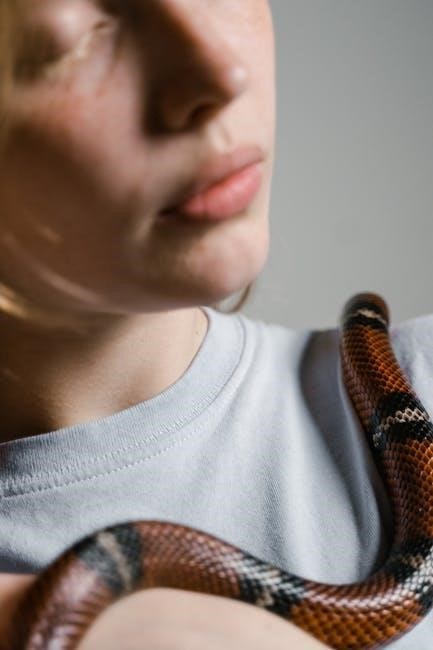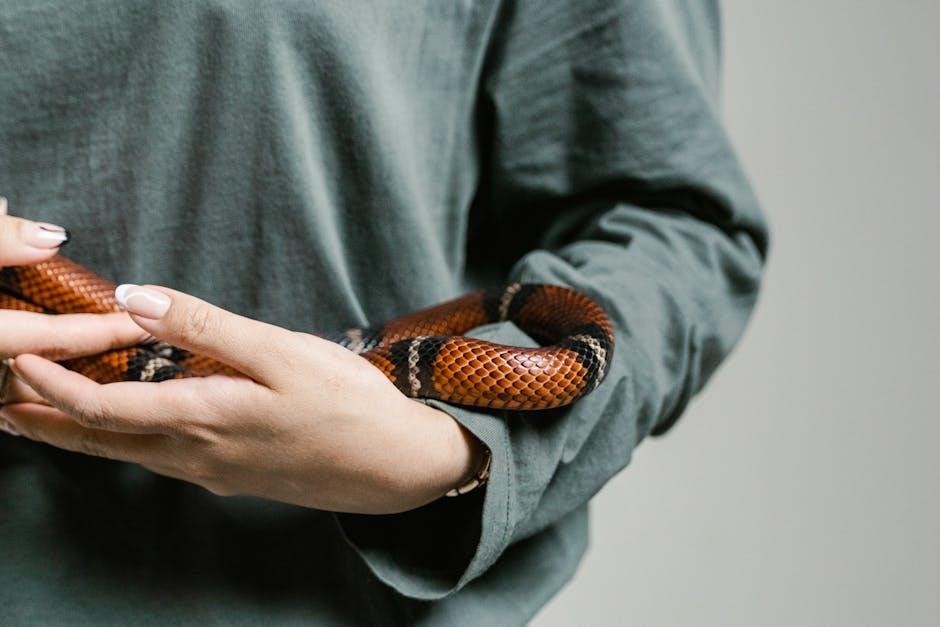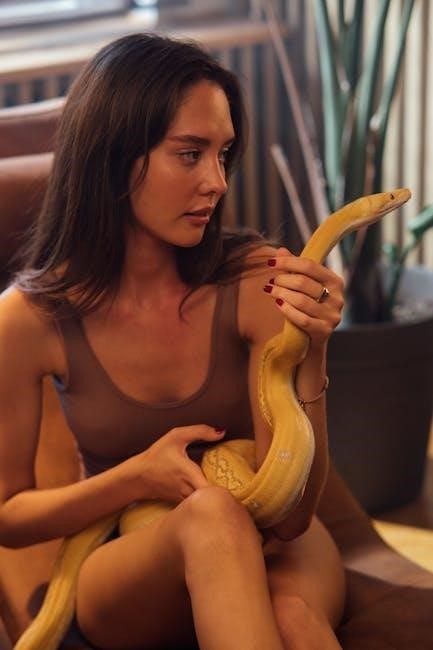Hognose snakes are popular, calm, and manageable pets. They require specific care to thrive, including proper feeding, habitat setup, and regular maintenance. This guide provides essential tips for their care.
1.1 Overview of Hognose Snakes
Hognose snakes, belonging to the genus Heterodon, are small, non-venomous snakes native to North America. Known for their distinctive upturned snouts, they are calm, docile, and popular pets. These snakes are rear-fanged and primarily feed on small prey like frogs and toads. Their unique appearance and manageable size make them a favorite among reptile enthusiasts and beginners alike.
1.2 Importance of Proper Care
Proper care is crucial for the health and well-being of hognose snakes. Improper care can lead to health issues, stress, and a shortened lifespan. By providing the right environment, diet, and maintenance, owners ensure their snake thrives. Proper care also fosters trust, making handling easier and more enjoyable for both the snake and owner, creating a positive and rewarding pet experience.
Habitat and Environment
Creating a suitable habitat is vital for hognose snakes. A 10-20 gallon tank with a secure lid is ideal. Use a substrate like aspen or sand, and include hiding places. Maintain a temperature range of 75-85°F with a basking spot of 90°F. Proper ventilation and humidity levels are also essential for their comfort and health.
2.1 Tank Size Recommendations
A juvenile hognose snake thrives in a 10-gallon tank, providing ample space for movement. As the snake grows, upgrade to a 20-gallon tank to accommodate its increased size. Ensure the tank is well-ventilated and secure, as hognose snakes are skilled escape artists. A larger tank also allows for better temperature gradients and humidity control, essential for their health and comfort long-term.
2.2 Substrate and Decorations
The best substrates for hognose snakes are newspaper, indoor/outdoor carpeting, or reptile carpet. Avoid loose substrates like sand or wood shavings, as they can cause respiratory issues. Decorations should include hiding places, such as small caves or plants, to reduce stress. Adding rocks or logs for basking spots also enhances the environment, making the tank more comfortable and stimulating for the snake.
2.3 Temperature and Lighting Requirements
Hognose snakes require a temperature gradient of 75-85°F for the cooler side and 85-90°F for the basking area. Use low-wattage bulbs or LED lights to maintain heat without direct sunlight, which can overheat the tank. Lighting should follow a 10-12 hour photoperiod to mimic natural day-night cycles, ensuring proper thermoregulation and overall health.
Diet and Feeding
Hognose snakes primarily eat mice or rats. Hatchlings should be fed weekly, while adults can be fed every 7-10 days. Avoid handling for 24 hours post-feeding.
3.1 Prey Size and Frequency
Hognose snakes are carnivorous, feeding on mice or rats. Hatchlings need small prey like pinkie mice every 3-4 days. As they grow, increase prey size gradually. Adults typically eat larger mice or rats weekly. Ensure prey is appropriately sized for the snake’s weight and defrosted to body temperature before feeding. Avoid handling for 24 hours after meals.
3.2 Feeding Techniques and Tips
Feed hognose snakes using feeding tongs to avoid associating your hand with food. Offer prey in the evening when they are most active. Live or frozen-thawed mice/rats work well; some snakes prefer live prey. Ensure the snake has access to water nearby. If a snake refuses food, wait a few days before trying again. Avoid handling post-feeding to aid digestion.
3.4 Common Food Items (Mice, Rats, etc.)
Hognose snakes primarily eat small mammals like mice and rats. Hatchlings start with pinkie mice, progressing to fuzzy and hopper mice as they grow. Sub-adults and adults eat rat pups or small rats. A feeding chart based on the snake’s weight ensures appropriate prey size, promoting healthy growth and digestion. Live or frozen-thawed options are suitable.

Handling and Temperament
Hognose snakes are known for their calm and docile nature, making them ideal pets. They tolerate handling well, especially when young. Always support their body during handling and avoid handling immediately after feeding, as this can cause stress. With proper care, they remain friendly and manageable.
4.1 Handling Tips for Beginners
Beginners should start by washing their hands to ensure cleanliness. Gently scoop up the snake, fully supporting its body. Avoid handling for 24 hours after feeding to prevent stress. Start with short sessions to build trust. Handle the snake in the morning when it’s most calm. Never handle a snake that appears stressed or aggressive. Ensure the environment is safe and free from hazards.
4.2 Understanding Hognose Snake Behavior
Hognose snakes are generally calm and docile, making them ideal pets. They often exhibit curiosity and may bask on rocks or explore their environment. Stress signs include hissing or flattening their heads. They are primarily solitary and have predictable behaviors once accustomed to their habitat. Understanding these traits helps in creating a comfortable and stress-free living environment for your pet.
Health and Hygiene
Regular cleaning and proper hygiene are crucial for preventing health issues like respiratory infections and parasites. A clean environment ensures your hognose snake stays healthy and thrives.
5.1 Common Health Issues
Hognose snakes are generally hardy but can face health issues like respiratory infections, skin problems, and parasitic infestations. Poor ventilation and humidity often lead to respiratory distress, while improper feeding can cause internal parasites. Regular vet check-ups and a clean environment help prevent these issues and ensure optimal health for your pet snake.
5.2 Cleaning and Maintenance
Regular cleaning is crucial for maintaining a healthy environment for hognose snakes. Remove feces and uneaten food promptly, and replace the substrate completely every 2-3 months. Disinfect all surfaces with a reptile-safe cleaning solution to prevent bacterial growth. A clean habitat reduces the risk of health issues and ensures your snake’s well-being and happiness.

Breeding and Reproduction
Breeding hognose snakes requires a mature, healthy pair. Ensure proper environment and nutrition for successful reproduction. Breeding typically begins when snakes are around 2-3 years old.
6.1 Breeding Conditions and Setup
Creating a suitable environment is crucial for breeding hognose snakes. Ensure a temperature gradient of 75-85°F with a humidity level around 30-50%. Provide hiding places to reduce stress. Introduce the male to the female’s enclosure during the breeding season, typically in spring. Monitor behavior closely and separate them if aggression occurs. Proper setup enhances reproductive success.
6.2 Egg Incubation and Hatchlings
Hognose snakes typically lay clutches of 6-23 eggs, which incubate for 60-70 days at 78-82°F. Hatchlings are 6-8 inches long, requiring a small, escape-proof enclosure with proper substrate and hiding places. Start feeding pinkie mice every 3-4 days. Monitor their growth and adjust prey size as they develop.
Lifespan and Growth Rate
Hognose snakes typically live 15-20 years in captivity. They grow steadily, reaching full size within 3-4 years. Proper care ensures optimal growth and longevity.
7.1 Average Lifespan in Captivity
Hognose snakes typically live between 15 to 20 years in captivity when properly cared for. Their lifespan is influenced by factors such as diet, habitat conditions, and regular health check-ups. With a balanced diet and a clean environment, these snakes can thrive and make long-term pets. Proper care ensures they reach their full lifespan potential.
7.2 Growth Stages and Size Expectations
Hognose snakes experience steady growth, with hatchlings averaging 6-8 inches. Juveniles grow rapidly, reaching 12-18 inches within the first year. Adults typically measure 15-25 inches, depending on species. Proper feeding and care ensure healthy growth. Regular monitoring helps track development, ensuring appropriate prey sizes and habitat adjustments as the snake matures. Average adult size varies slightly by species.
Substrate and Hiding Places
The best substrates for hognose snakes include aspen, cypress mulch, or reptile carpet. Hiding places, like logs or boxes, reduce stress and prevent escape attempts.
8.1 Best Substrate Options
The best substrates for hognose snakes include aspen, cypress mulch, or reptile carpet. These options retain humidity and are easy to clean. Avoid gravel or sand, as they can cause impaction. Aspen is a popular choice due to its absorbency and natural appearance. Cypress mulch also helps maintain proper humidity levels, promoting a healthy environment for your snake. Newspaper or indoor/outdoor carpeting are cost-effective alternatives.
8.2 Importance of Hiding Places
Hiding places are crucial for hognose snakes to reduce stress and feel secure. They provide a sense of safety, essential for the snake’s mental and physical health. Logs, plants, or commercial hiding houses are excellent options. These spots also aid in thermoregulation, allowing the snake to regulate its body temperature effectively. A stress-free environment promotes overall well-being and longevity.

Heating and Lighting
Hognose snakes need a temperature gradient of 75-85°F with a basking spot of 90°F. Use low-wattage bulbs or LEDs for heat, avoiding UVB unless necessary. Maintain a 10-12 hour photoperiod for natural cycles.
9.1 Heating Sources and Placement
Use heat mats or ceramic heat emitters for maintaining a temperature gradient. Place heat sources at one end of the tank to create a 75-85°F gradient with a 90°F basking spot; Avoid direct heat exposure by using a thermostat. Position thermometers to monitor temperatures accurately. Ensure proper placement to prevent hotspots and maintain snake safety. This setup mimics natural conditions effectively.
9.2 Lighting Options and Photoperiod
LED or T5 lights are ideal for hognose snakes, providing a 10-12 hour photoperiod. UVB lighting isn’t essential but can enhance their environment. Maintain a consistent light cycle to regulate their circadian rhythm. Separate the basking spot from ambient light to mimic natural conditions, promoting healthy behavior and thermoregulation. Avoid direct exposure to heat sources without proper shielding for safety.

Shedding and Skin Care
Shedding is a natural process for hognose snakes, typically occurring in one piece. Ensure a water bowl for soaking during shedding. Maintain a clean environment for skin health and hygiene.
10.1 Shedding Process and Care
Hognose snakes shed their skin periodically as they grow. Ensure a clean, humid environment to aid shedding. A water bowl large enough for soaking is essential. Monitor humidity levels, maintaining 30-50% to prevent complications. Signs of shedding include dull color and increased mucous. Provide a humid hide box to facilitate the process, ensuring a stress-free shed cycle for your pet.
10.2 Maintaining Healthy Skin
Maintaining healthy skin for hognose snakes involves proper humidity and a clean environment. Ensure a water bowl large enough for soaking to keep skin moist. Regularly clean the tank to prevent bacterial growth. Provide a humid hide box to maintain optimal moisture levels, promoting healthy shedding and skin integrity. Avoid excessive handling during shedding to prevent stress and skin damage.
Cost and Budgeting
Budgeting for a hognose snake involves initial setup costs for a tank, substrate, heating, and hiding places. Ongoing expenses include food, electricity, and occasional vet visits. Affordable pet option.
11.1 Initial Setup Costs
Setting up a hognose snake habitat requires a significant initial investment. A suitable tank, substrate, heating elements, and accessories like hiding places and a water bowl are essential. Costs typically range between $200 to $400, depending on the size and quality of the equipment chosen. This setup ensures a safe and comfortable environment for your pet snake to thrive in.
11.2 Ongoing Expenses
Ongoing costs for hognose snake care include food, substrate replacements, and occasional habitat accessories. Feeding typically involves weekly prey items, with costs averaging $10-$20 monthly. Substrate and decoration updates add $20-$30 every few months. Lighting and heating elements may need periodic replacement, adding $30-$50 annually. Veterinary check-ups, though less frequent, should also be budgeted for, ensuring long-term health and well-being.
Caring for a hognose snake requires attention to habitat, diet, and health. With proper care, they thrive, offering a rewarding pet experience for enthusiasts;
12.1 Summary of Key Care Points
Proper hognose snake care involves a suitable habitat, balanced diet, and regular maintenance. Provide appropriate tank size, substrate, and hiding places. Feed prey items like mice or rats, adjusting size as the snake grows. Maintain correct temperature and lighting, and ensure fresh water. Handle gently and avoid post-feeding interaction. Monitor health and clean the enclosure regularly for a thriving pet.
12.2 Final Tips for Successful Hognose Snake Care
Always observe your snake’s behavior for signs of stress or illness. Provide a varied, nutrient-rich diet and ensure proper hydration. Maintain a clean, well-ventilated habitat with appropriate temperature gradients. Handle gently and avoid interaction after feeding. Stay informed about species-specific needs and adapt care as your snake grows. Patience and consistency are key to fostering a healthy, thriving pet.